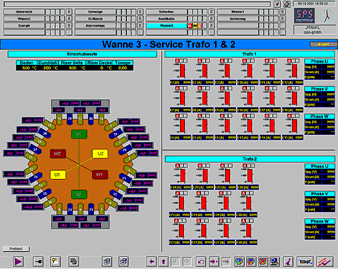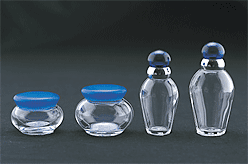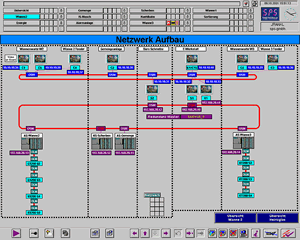PCS7 systems with special fuzzy-algorithms and individual software modules
During the overall automation of the production plant of Heinz–Glas in Kleintettau, the new constructed tank 3 should be integrated into the existing PCS7 system. Some new controlling concepts were introduced to optimize the production process. The glass temperatures within the feeders are now regulated by special fuzzy-algorithms to largely eliminate bead weight fluctuations due to temperature variations. To provide faster reaction time to the operator personnel, the alarm system was connected to the existing radio call system.
After the successful commissioning of tank 2 and its integration into the PCS7 system by SPS Schlemmer Process Systeme GmbH, it was clear, that also the new electric tank furnace must be integrated into the process control system. Close cooperation with the furnace technology and MSR department of Heinz-Glas yielded an automation concept which comprised latest methods and technologies as well as existing know-how.
Modern bus topologies ensure efficient data exchange
The implementation of the new controller and the new operator panels was not hampered by problems, because efficient bus systems and system components have already been integrated during the construction of tank 2. The Ethernet buses for both AS network and PC network consist of an optical waveguide ring with 100 MBit data rate. This design ensures maximum performance at high reliability. Two additional operator panels were installed for process controlling. One of these panels is directly next to one of the machine operator. This allows fast reaction in case of changing production conditions or in case of modifications. To monitor the batch carpet, a camera´s was integrated and displayed at the operator panel.
Cost control through production data acquisition
To determine production costs, the power and gas consumption is monitored and logged. Information about the prevailing average and the bead weight allow determination of the production costs of the item of interest. Data collected from long term studies allow conclusions about the energy consumption of the melting plant during the whole tank trip.

Reduction of material strain by monitoring and „gentle treatment“

To provide homogenous current flow and to avoid irregularly burnt electrodes, the single currents are displayed in relation to each other in special service diagrams. By means of adjustable alarm limits for the electrode currents and temperatures, all components are monitored and alarm reports are made on demand. The plant operator is warned in time of an impending „electrode sliding“.
In most cases, it doesn´t matter if the new value is reached five minutes earlier or later after some modification or setpoint adjustment. Moreover, it is important to avoid material strain due to setpoint jumps. For this reason, all control circuits are equipped with adjustable time ramps which allow controlled switching from one working point to the next. The setting of these ramps means a compromise between change rate and material strain. Another positive effect can be seen in the minimized overshoot or undershoot during setpoint changes.
High temperature and weight stability
through glass temperature fuzzy control
To ensure bead weight as stable as possible, the glass temperatures are measured and adjusted in the feeders rather than the dome temperatures. This way of measurement means longer reaction times and requires more sophisticated control algorithms. To provide high control accuracy with high control dynamics, special fuzzy-components were integrated into the system. The functions ensure fast reaction of the controls to interferences, despite long delay times.
Connection to third-party components
through individual software modules

All relevant interference reports are collected within the PCS7 system and displayed at the operator panel. Since it is known that the operator spends more time on site at the plant than in the control room, Heinz-Glas demanded integration of the existing BOSCH radio call system. This system consists of a radio control station and several receivers which can be contacted all over the company area. The receivers show the respective report on a text display. Unfortunately, the standard software wasn’t suitable for the integration, so SPS Schlemmer Prozess Systeme GmbH developed new software. This coupling sends all assigned alarms to the radio call system via a serial interface. The assignment of alarms to the respective users is decided by the plant owner. To preserve high availability of the whole plant, the software was designed for redundant operation, which means that the operator panel will be supplied by another data server in case of failure of the first. Also the radio call system gets data from the second server in case of malfunction.
With the integration of tank 3 Heinz-Glas has made another step towards an „intragroup automation concept“. Efficient and future-looking technologies are a key prerequisite for economic glass manufacture. With high-quality projects SPS Schlemmer Prozess Systeme GmbH has proven their competence in this field.




